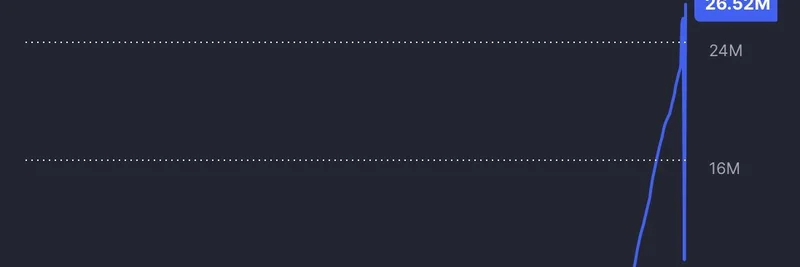If you've been wondering why your altcoin portfolio hasn't skyrocketed like in previous bull runs, a recent tweet from @StarPlatinumSOL might hold the key. The post shares a striking chart from CoinMarketCap showing the explosive growth in the number of tracked cryptocurrencies, jumping from thousands to millions in recent years. This overload, coupled with retail frenzy over memecoins, has left many traditional altcoins in the dust.
Understanding the Chart: From Thousands to Millions
The chart illustrates the "Total Tracked" cryptocurrencies on CoinMarketCap, starting flat around 2015 and skyrocketing post-2022 to over 26 million. In earlier cycles—like the 2017 ICO boom or the 2021 DeFi summer—there were only a few thousand tokens vying for attention. Now, platforms like Solana and Pump.fun have made launching memecoins as easy as posting a tweet, flooding the market with speculative assets.
This proliferation means liquidity is spread thin. Instead of concentrating on established altcoins with real utility, capital flows into viral memecoins driven by hype, social media buzz, and FOMO (fear of missing out). As the tweet points out, "Retail burned itself chasing memecoins," referring to everyday investors getting rekt on rug pulls and pump-and-dumps.
The Memecoin Mania and Its Impact on Altcoins
Memecoins, those fun, often joke-based tokens like Dogecoin or newer ones on Solana, have dominated this cycle. They're cheap to create, easy to market via influencers, and can go parabolic overnight. But with millions of options, the signal-to-noise ratio is abysmal. Serious projects struggle to stand out, while scam tokens extract liquidity from unsuspecting traders.
Community reactions in the replies echo this sentiment. One user notes, "Millions of tokens were created to extract liquidity," highlighting the predatory side of the space. Another adds, "Too many coins, not enough money to go around," underscoring the dilution effect. Even as Bitcoin and Ethereum hit new highs, altcoins lag because retail capital is fragmented across countless memes.
Lessons for Blockchain Practitioners
For those building or investing in the space, this trend underscores the need for due diligence. Focus on tokens with strong communities, real-world utility, or innovative tech rather than pure hype. Tools like DexScreener can help spot promising memecoins early, but remember: high risk often means high reward—or total loss.
As the market matures, we might see consolidation, with quality projects rising above the noise. Until then, stay informed and avoid chasing every shiny new token. What are your thoughts on this cycle's altcoin performance? Share in the comments below!


